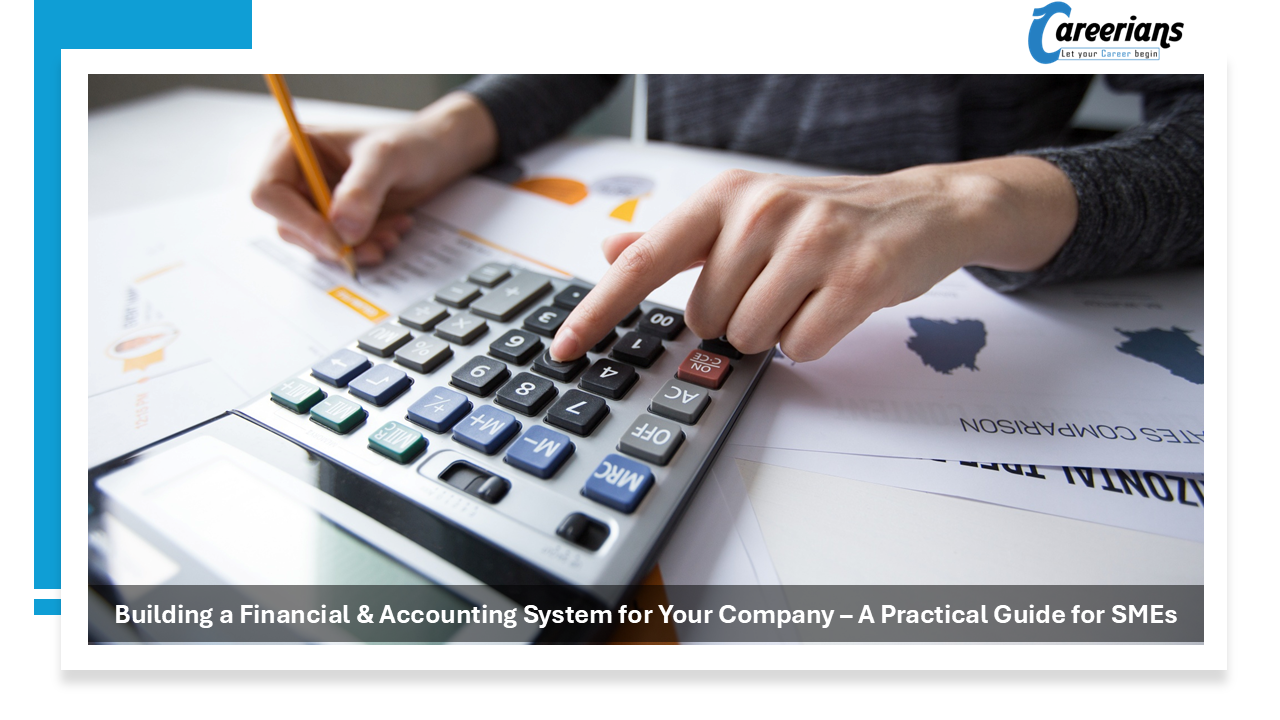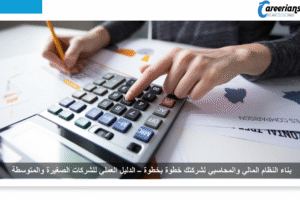
Building a Financial and Accounting System for Your Company – A Practical Guide for Small and Medium Enterprises
Building a Financial and Accounting System for Your Company – A Practical Guide for Small and Medium Enterprises
Financial and Accounting System is not just about bookkeeping or balancing debits and credits. It’s about building the financial backbone that keeps your business alive, healthy, and growing.
When a company doesn’t have a proper financial system, it loses control — expenses go untracked, revenues become unclear, and management ends up making decisions based on guesses instead of facts.
In Egypt and the Gulf, thousands of companies fail to grow not because their business idea was bad, but because their financial foundation was weak.
This article will walk you step by step through how to build a practical financial and accounting system from scratch — one that fits your business size and actually works in real life.
Step 1: Understand Your Business Nature Before You Start
The first mistake many accountants make is starting with software instead of understanding the business itself.
Before choosing an accounting program or creating a chart of accounts, you must clearly answer:
👉 What kind of business are we running?
-
Trading companies (e.g., electronics, construction materials) focus on purchases, sales, and inventory control.
-
Manufacturing companies (e.g., food, beverages, machinery) need cost accounting, production tracking, and raw materials control.
-
Service companies (e.g., consulting, IT, logistics) require project-based accounting and revenue recognition.
Example
A trading company in Egypt needs strong inventory and sales control to manage cash flow.
A contracting company in Saudi Arabia needs to track each project separately, with its own cost center and budget.
A consulting office in Dubai focuses more on client billing and time tracking.
👉 The type of activity determines the design of the entire accounting system.
Step 2: Define the Objective of Your Financial System
You can’t build a system if you don’t know what you expect it to do.
Ask yourself:
“Do we only want to comply with legal reporting, or do we want to manage our finances and make better decisions?”
Every company usually passes through three stages:
1️⃣ Recording stage – Focus on capturing all financial transactions correctly.
Example: Recording supplier invoices, sales receipts, and petty cash expenses.
2️⃣ Control stage – Focus on monitoring expenses and cash movement.
Example: Expense approvals, monthly bank reconciliation, cash flow tracking.
3️⃣ Decision stage – Use the data for financial analysis and decision-making.
Example: Evaluating profitability per project or forecasting future liquidity.
A strong accountant understands how to move the company from stage 1 to stage 3 smoothly.
Step 3: Design the Financial Structure
1. Chart of Accounts (COA)
Your chart of accounts is the DNA of your accounting system.
It defines how every transaction will be classified, summarized, and reported.
Example structure for a medium-sized Egyptian trading company:
Assets
-
Fixed assets
-
Inventory
-
Accounts receivable
-
Cash & bank
Liabilities
-
Accounts payable
-
Accrued expenses
-
Bank loans
Equity
-
Share capital
-
Retained earnings
Income
-
Sales (wholesale / retail)
-
Other revenues
Expenses
-
Cost of goods sold
-
Administrative expenses
-
Marketing expenses
Keep it simple and consistent. Don’t over-complicate the COA — clarity is more valuable than size.
2. Cost Centers
Cost centers are the accountant’s compass for analyzing performance.
Each department, project, or branch can be treated as a separate cost center.
Example
A construction company in Riyadh creates a cost center for each project site.
A manufacturing plant in 10th of Ramadan creates separate centers for each production line (water, soda, juice).
When analyzed monthly, this helps identify which projects or products generate profit — and which are draining cash.
3. Document Flow
Every financial action must have documentation.
Without it, you can’t audit, prove, or control anything.
Common documents include:
-
Purchase orders
-
Supplier invoices
-
Delivery notes
-
Payment vouchers
-
Bank statements
-
Petty cash forms
In Gulf companies, document flow is often automated through ERP systems with digital approval workflows.
In Egypt, many SMEs still rely on Excel or paper, but the principle remains the same — no entry without a document.
Step 4: Choose the Right Accounting System
The tool should fit your business — not the other way around.
Manual or Electronic?

In early stages, Excel sheets can be acceptable. But as transactions grow, you need a system that ensures accuracy, speed, and reporting.
Popular software options:
-
QuickBooks / Zoho Books – Simple and cloud-based for small businesses.
-
Odoo / ERPNext – Flexible and suitable for growing SMEs needing integrated modules.
-
SAP / Oracle Financials – Enterprise-level solutions for large corporations.
👉 Important: Even the best software will fail if your internal processes are weak.
Good accounting systems don’t replace discipline — they enhance it.
Step 5: Build the Daily Accounting Cycle
Every accountant must master the daily cycle — it’s the heartbeat of the financial system.

1. Journal Entries
Record every transaction promptly.
Example:
Purchase of raw materials in cash
Dr. Purchases
Cr. Cash
2. Posting to the General Ledger
Each journal entry is posted to its corresponding ledger account.
3. Trial Balance
At month-end, verify that total debits equal total credits. Any difference means an error exists.
4. Month-End Closing
Close temporary accounts and prepare for reporting.
5. Financial Statements
Generate monthly financial reports — not just yearly.
In one Saudi retail chain, moving from yearly to monthly reporting helped identify excessive logistics costs early and saved 400,000 SAR in one quarter.
Step 6: Internal Controls and Financial Discipline
A professional financial system must include control procedures.
These controls prevent fraud, ensure accuracy, and maintain financial integrity.
Key control practices:
-
Segregation of duties – The person who approves isn’t the one who records or pays.
-
Bank reconciliation – Match statements monthly.
-
Inventory audits – Schedule physical counts quarterly.
-
Spending limits – Any expense above a certain threshold must be approved by the Finance Manager.
Example
A company in Cairo introduced digital invoice approvals using Zoho Books’ workflow.
Result: Expense errors dropped by 75% in two months.
Internal control = trust with verification.
Step 7: Financial Reporting and Analysis
Accounting data becomes powerful when analyzed properly.
Financial reports turn numbers into insights.
Essential reports every SME should use:
-
Profit & Loss Statement (P&L) – Measures profitability.
-
Balance Sheet – Shows financial position (assets vs liabilities).
-
Cash Flow Statement – Reveals liquidity and timing of cash inflows/outflows.
-
Aging Reports (AR/AP) – Track customer payments and supplier dues.
-
Expense Analysis by Cost Center – Detects inefficiencies.
Real-world case
A beverage company in Egypt analyzed cost per product line.
They discovered that one flavor’s packaging cost was eating half the profit margin.
After renegotiating with suppliers, net profit improved by 12% in one quarter.
Step 8: Develop Financial Policies and Procedures
Policies are the rules of the game.
Without them, your accounting system becomes a collection of random practices.
A standard financial policy manual should include:
-
Expense authorization levels
-
Petty cash procedures
-
Procurement workflow
-
Depreciation methods
-
Month-end and year-end closing timelines
Having documented policies also protects accountants from unnecessary blame — decisions become structured, not personal.
Step 9: Compliance and External Reporting
Every system must comply with the local laws and authorities:
In Egypt
-
E-invoicing and e-receipts are mandatory for most companies.
-
VAT, income tax, and payroll tax filings must be electronic.
In Saudi Arabia and the UAE
-
VAT and ZATCA e-invoicing compliance are compulsory.
-
Payroll must match GOSI (Saudi) or MOHRE (UAE) records.
A good accounting system should easily generate compliant reports for these authorities.
Step 10: Continuous Improvement and Staff Training
A financial system is not something you set once and forget.
It must evolve as your business grows.
-
Update your chart of accounts yearly.
-
Review your cost centers as operations expand.
-
Upgrade your ERP when you add new branches or departments.
-
Train your accounting team regularly — knowledge is your biggest investment.
Example
A logistics company in Dubai implemented Odoo ERP and held weekly internal workshops for a month.
Result: Closing time dropped from 10 days to 4 days, and reporting accuracy improved by 35%.
Practical Tips for Junior Accountants
-
Always understand the transaction before recording it.
-
Never post without supporting documents.
-
Reconcile cash and bank every month.
-
Use Excel for analysis, but rely on the accounting system for records.
-
Keep communication open with operations, sales, and HR — accounting doesn’t work in isolation.
-
Learn the logic behind financial statements — that’s what makes you a real accountant.
Final Thoughts
A solid financial system isn’t built overnight.
It grows with your discipline, accuracy, and understanding of the business.
Whether you’re a new accountant or the first finance person in a startup, start small but build correctly.
Design your chart of accounts, define your workflows, and keep refining.
Remember:
Numbers tell stories — your job is to make sure the story is true.
Accounting is not just about compliance; it’s about clarity.
And clarity is what drives confident business decisions.
Tag:Accounting Cycle, Accounting Document Flow, Accounting System, Building a Financial and Accounting System, Cost Centers, Financial & Accounting System, Financial Analysis, Financial Discipline, Financial Policies, Financial Procedures, Financial Reporting, Financial Structure, Internal Controls, Objective of Your Financial System




